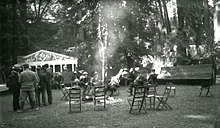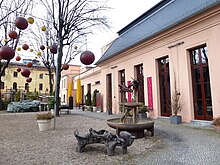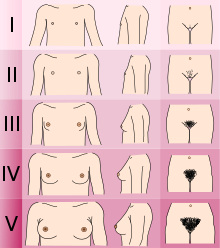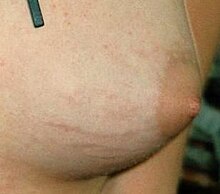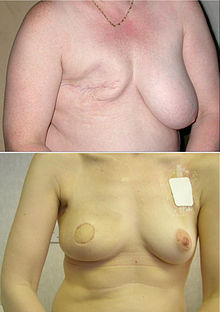Pierre-Auguste Renoir, The Bohemian (or Lise the Bohemian), 1868, oil on canvas, Berlin, Germany: Alte Nationalgalerie
Bohemianism is the practice of an unconventional
lifestyle, often in the company of like-minded people and with few
permanent ties. It involves musical, artistic, literary or spiritual
pursuits. In this context, Bohemians may or may not be wanderers, adventurers, or vagabonds.
This use of the word bohemian first appeared in the English
language in the 19th century to describe the non-traditional lifestyles
of marginalized and impoverished artists, writers, journalists, musicians, and actors in major European cities.
Bohemians were associated with unorthodox or anti-establishment political or social viewpoints, which often were expressed through free love, frugality, and—in some cases—simple living or voluntary poverty. A more economically privileged, wealthy, or even aristocratic bohemian circle is sometimes referred to as haute bohème (literally "high Bohemia").
The term bohemianism emerged in France in the early 19th century
when artists and creators began to concentrate in the lower-rent, lower
class, Romani neighborhoods. Bohémien was a common term for the Romani people of France, who were mistakenly thought to have reached France in the 15th century via Bohemia (the western part of modern Czech Republic).
Origins
European bohemianism
Literary bohemians were associated in the French imagination with roving Romani people (called Bohémiens because they were believed to have arrived from Bohemia), outsiders apart from conventional society and untroubled by its disapproval. The term carries a connotation of arcane enlightenment (the opposite of Philistines), and carries a less frequently intended, pejorative connotation of carelessness about personal hygiene and marital fidelity.
The title character in Carmen (1876), a French opera set in the Spanish city of Seville, is referred to as a "bohémienne" in Meilhac and Halévy's libretto. Her signature aria declares love itself to be a "gypsy child" (enfant de Bohême), going where it pleases and obeying no laws.
The term bohemian has come to be very commonly accepted in our day as the description of a certain kind of literary gypsy, no matter in what language he speaks, or what city he inhabits .... A Bohemian is simply an artist or "littérateur" who, consciously or unconsciously, secedes from conventionality in life and in art.
— Westminster Review, 1862
Henri Murger's collection of short stories "Scènes de la Vie de Bohème" ("Scenes of Bohemian Life"), published in 1845, was written to glorify and legitimize Bohemia. Murger's collection formed the basis of Giacomo Puccini's opera La bohème (1896).
In England, bohemian in this sense initially was popularised in William Makepeace Thackeray's novel, Vanity Fair, published in 1848. Public perceptions of the alternative lifestyles supposedly led by artists were further molded by George du Maurier's romanticized best-selling novel of Bohemian culture Trilby (1894). The novel outlines the fortunes of three expatriate English artists, their Irish model, and two colourful Central European musicians, in the artist quarter of Paris.
In Spanish literature, the Bohemian impulse can be seen in Ramón del Valle-Inclán's play Luces de Bohemia, published in 1920.
In his song La Bohème, Charles Aznavour described the Bohemian lifestyle in Montmartre. The film Moulin Rouge! (2001) also reflects the Bohemian lifestyle in Montmartre at the turn of the 20th century.
American bohemianism
Bohemian Grove during the summer Hi-Jinks, circa 1911–1916
In the 1850s, aesthetic bohemians began arriving in the United States. In New York City in 1857, a group of 15 to 20 young, cultured journalists flourished as self-described bohemians until the American Civil War began in 1861. This group gathered at a German bar on Broadway called Pfaff's beer cellar. Members included their leader Henry Clapp, Jr., Ada Clare, Walt Whitman, Fitz Hugh Ludlow, and actress Adah Isaacs Menken.
Similar groups in other cities were broken up as well by the
Civil War and reporters spread out to report on the conflict. During the
war, correspondents began to assume the title bohemian, and
newspapermen in general took up the moniker. Bohemian became synonymous
with newspaper writer. In 1866, war correspondent Junius Henri Browne, who wrote for the New York Tribune and Harper's Magazine,
described bohemian journalists such as he was, as well as the few
carefree women and lighthearted men he encountered during the war years.
San Francisco journalist Bret Harte first wrote as "The Bohemian" in The Golden Era in 1861, with this persona taking part in many satirical doings, the lot published in his book Bohemian Papers
in 1867. Harte wrote, "Bohemia has never been located geographically,
but any clear day when the sun is going down, if you mount Telegraph Hill, you shall see its pleasant valleys and cloud-capped hills glittering in the West ..."
Mark Twain included himself and Charles Warren Stoddard in the bohemian category in 1867.
By 1872, when a group of journalists and artists who gathered regularly
for cultural pursuits in San Francisco were casting about for a name,
the term bohemian became the main choice, and the Bohemian Club was born.
Club members who were established and successful, pillars of their
community, respectable family men, redefined their own form of
bohemianism to include people like them who were bons vivants, sportsmen, and appreciators of the fine arts. Club member and poet George Sterling responded to this redefinition:
Any good mixer of convivial habits considers he has a right to be called a bohemian. But that is not a valid claim. There are two elements, at least, that are essential to Bohemianism. The first is devotion or addiction to one or more of the Seven Arts; the other is poverty. Other factors suggest themselves: for instance, I like to think of my Bohemians as young, as radical in their outlook on art and life; as unconventional, and, though this is debatable, as dwellers in a city large enough to have the somewhat cruel atmosphere of all great cities.
— Parry, 2005.
Despite his views, Sterling associated with the Bohemian Club, and caroused with artist and industrialist alike at the Bohemian Grove.
Canadian composer Oscar Ferdinand Telgmann and poet George Frederick Cameron wrote the song "The Bohemian" in the 1889 opera Leo, the Royal Cadet.
The impish American writer and Bohemian Club member Gelett Burgess, who coined the word blurb, supplied this description of the amorphous place called Bohemia:
Gelett Burgess drew this fanciful "Map of Bohemia" for The Lark, March 1, 1896 (see also The Winter's Tale § The seacoast of Bohemia)
To take the world as one finds it, the bad with the good, making the best of the present moment—to laugh at Fortune alike whether she be generous or unkind—to spend freely when one has money, and to hope gaily when one has none—to fleet the time carelessly, living for love and art—this is the temper and spirit of the modern Bohemian in his outward and visible aspect. It is a light and graceful philosophy, but it is the Gospel of the Moment, this exoteric phase of the Bohemian religion; and if, in some noble natures, it rises to a bold simplicity and naturalness, it may also lend its butterfly precepts to some very pretty vices and lovable faults, for in Bohemia one may find almost every sin save that of Hypocrisy. ...
His faults are more commonly those of self-indulgence, thoughtlessness, vanity and procrastination, and these usually go hand-in-hand with generosity, love and charity; for it is not enough to be one’s self in Bohemia, one must allow others to be themselves, as well. ...
What, then, is it that makes this mystical empire of Bohemia unique, and what is the charm of its mental fairyland? It is this: there are no roads in all Bohemia! One must choose and find one’s own path, be one’s own self, live one’s own life.
— Ayloh, 1902
In New York City, pianist Rafael Joseffy formed an organization of musicians in 1907 with friends, such as Rubin Goldmark, called "The Bohemians (New York Musicians' Club)". Near Times Square Joel Renaldo
presided over "Joel’s Bohemian Refreshery" where the Bohemian crowd
gathered from before the turn of the 20th century until Prohibition
began to bite. Jonathan Larson's musical Rent, and specifically the song "La Vie Boheme," portrayed the postmodern Bohemian culture of New York in the late 20th century.
In May 2014, a story on NPR
suggested, after a century and a half, some Bohemian ideal of living in
poverty for the sake of art had fallen in popularity among the latest
generation of American artists. In the feature, a recent graduate of the
Rhode Island School of Design related "her classmates showed little interest in living in garrets and eating ramen noodles."
People
The term
has become associated with various artistic or academic communities and
is used as a generalized adjective describing such people, environs, or
situations: bohemian (boho—informal) is defined in The American College Dictionary as "a person with artistic or intellectual tendencies, who lives and acts with no regard for conventional rules of behavior."
Many prominent European and American figures of the 19th and 20th centuries belonged to the bohemian subculture, and any comprehensive "list of bohemians" would be tediously long. Bohemianism has been approved of by some bourgeois writers such as Honoré de Balzac, but most conservative cultural critics do not condone bohemian lifestyles.
.
In Bohemian Manifesto: a Field Guide to Living on the Edge, author Laren Stover, breaks down the bohemian into five distinct mind-sets or styles, as follows:
- Nouveau: bohemians that are rich who attempt to join traditional bohemianism with contemporary culture
- Gypsy: the expatriate types, they create their own Gypsy ideal of nirvana wherever they go
- Beat: also drifters, but non-materialist and art-focused
- Zen: "post-beat," focus on spirituality rather than art
- Dandy: no money, but try to appear as if they have it by buying and displaying expensive or rare items – such as brands of alcohol
Aimée Crocker,
an American world traveler, adventuress, heiress, and mystic, was
dubbed the queen of Bohemia in the 1910s by the world press for living
an uninhibited, sexually liberated, and aggressively non-conformist life
in San Francisco, New York, and Paris. She spent the bulk of her
fortune inherited from her father Edwin B. Crocker,
a railroad tycoon and art collector, on traveling all over the world
(lingering the longest in Hawaii, India, Japan, and China) and partying
with famous artists of her time such as Oscar Wilde, Robert Louis Stevenson, Mark Twain, the Barrymores, Enrico Caruso, Isadora Duncan, Henri Matisse, Auguste Rodin, and Rudolph Valentino.
Crocker had countless affairs and married five times in five different
decades of her life, each man being in his twenties. She was famous for
her tattoos and pet snakes and was reported to have started the first
Buddhist colony in Manhattan. Spiritually inquisitive, Crocker had a
ten-year affair with occultist Aleister Crowley and was a devoted student of Hatha Yoga.
Maxwell Bodenheim, an American poet and novelist, was known as the king of Greenwich Village Bohemians during the 1920s and his writing brought him international fame during the Jazz Age.
Former brewery gone artist center in Prenzelberg
In the 20th-century United States, the bohemian impulse was famously seen in the 1940s hipsters, the 1950s Beat generation (exemplified by writers such as William S. Burroughs, Allen Ginsberg, Jack Kerouac, and Lawrence Ferlinghetti), the much more widespread 1960s counterculture, and 1960s and 1970s hippies.
Rainbow Gatherings may be seen as another contemporary worldwide expression of the bohemian impulse. An American example is Burning Man, an annual participatory arts festival held in the Nevada desert.
In 2001, political and cultural commentator David Brooks contended that much of the cultural ethos of well-to-do middle-class Americans is Bohemian-derived, coining the oxymoron ''Bourgeois Bohemians" or "Bobos". A similar term in Germany is Bionade-Biedermeier, a 2007 German neologism combining Bionade (a trendy lemonade brand) and Biedermeier
(an era of introspective Central European culture between 1815 and
1848). The coinage was introduced in 2007 by Henning Sußebach, a German
journalist, in an article that appeared in Zeitmagazin concerning Berlin's Prenzlauer Berg lifestyle. The hyphenated term gained traction and has been quoted and referred to since. A German ARD TV broadcaster used the title Boheme and Biedermeier in a 2009 documentary about Berlin’s Prenzlauer Berg.
The main focus was on protagonists, that contributed to the image of a
paradise for the (organic and kid raising) well-to-do, depicting cafés
where Bionade-Biedermeier sips from Fair-Trade.

